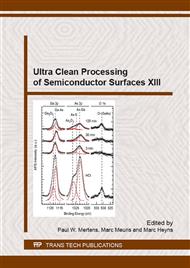p.168
p.172
p.176
p.182
p.186
p.195
p.201
p.207
p.215
Post-CMP Cleaners for Tungsten at Advanced Nodes
Abstract:
We discuss several mechanistic approaches and experimental data for improving post-CMP cleaning of W plugs with TiN as barrier liner, and dielectric substrates SiO2 and Si3N4 for use at the 10 nm technology node (metal pitch of 40 nm). Particle charge in the low pH, W CMP slurries are usually positive, and the W surface is always negatively charged at pH >3. Therefore, a strong electrostatic attraction is expected to occur between the W surface and the residual particles during post-CMP cleaning. Two main approaches were chosen to break down the strong particles-W surface post-CMP electrostatic interactions, as well as particles dispersion and prevention of redeposition: (1) using cleaning additives able to adsorb at the W surface and reverse the W surface charge; (2) using organic additives to reverse the particle charge. The latter approach results in two strongly negative charged surfaces, which are able to repulse each other, and leads to the best cleaning.
Info:
Periodical:
Pages:
186-194
Citation:
Online since:
September 2016
Price:
Сopyright:
© 2016 Trans Tech Publications Ltd. All Rights Reserved
Share:
Citation:


